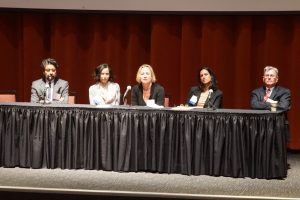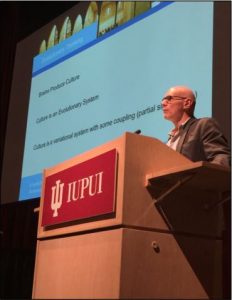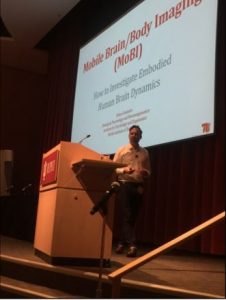By Juliet L. King, MA, ATR-BC, LPC, LMHC | May 18, 2017 | Events | Research
There is nothing more healing than seeing something in a different light and grander than your own existence. ~Anantha Shekhar, MD
It was with active minds and a collaborative spirit that the Schools of Art, Medicine, Engineering, Health and Rehabilitation Sciences, Nursing, Informatics and Liberal Arts came together to host the international symposium 21st Century Great Conversations in Neuroscience, Art and Related Therapeutics at Indiana University– Purdue University Indianapolis (IUPUI) in April. The premise of the symposium was to bring together campus faculty, healthcare professionals, community members, and thought leaders from around the world, to present insights and engage in transdisciplinary dialogue on how brain science and artistic processes inform one another with the shared vision that the intersection of art and science can support the overall health and amelioration of disease for patients, their caregivers, families and friends.

Neuroaesthetics panel, April, 2016. From left: Chatterjee, Saad, King Beckman, & Pascuzzi.
The Great Conversations Symposium was an idea born after attending a conference last summer on Mobile Brain-Body Imaging and the Neuroscience of Creativity and Innovation (August, 2016). I wanted to expand the thoughtful dialogue that took place and explore the various languages that are used to translate and make accessible our limitless ways of knowing in efforts to help people through research and clinical practice.
Presenters shared their insights and expertise within three wide ranging tracks that each had a designated Keynote speaker: (1) Neuroaesthetics; Anjan Chatterjee, MD; (2) Creativity and Consciousness; Arne Dietrich, PhD; and (3) Mobile Brain-Body Imaging; Klaus Gramann, PhD. A panel was formed for each track and was moderated by Jill Ditmire from WFYI radio, who engaged the audience with interactive dialogue that explored a range of subjects. The subjects included how creativity and the creative arts therapies are influenced by and relate to trauma and disease, physician training, consciousness and humanism, and neuroscience and brain imaging. See this website for details on presentation topics and proceedings of the podcast soon to be released. Primary themes included the nature of true collaborations and how these can be defined as the ability to look at the same phenomena from different angles.
The symposium provided a space for participants to engage in thoughtful, interactive conversations from divergent perspectives about what is “real” and what is assumed. Such dialogue is not all that common in science, medicine, or the arts. Embracing an information exchange is crucial if we want to address the Leviathan unknown of neurological disease, human health and illness, and the plagues of society in general.
Neuroscientists and creative arts therapists were at the nucleus of the many “atoms of thought,” forming alliances to promote a multi-modal approach to healing as essential in healthcare. Dr. Arne Dietrich informed us that, “neuroscientists are far more circumspect [than most others] about what neuroscience has to offer,” and added that a cogent neuroscience cannot exist without a good psychology. This perspective provides an opening for the creative arts therapies to inform the understanding of both implicit and explicit systems through the use of symbolic knowledge and expression. An additional tangible outcome of the symposium is the necessary inclusion of hard-core science to drive the methodologies that will assist creative arts therapies professionals to conduct research that will increase the evidence base, including randomized control trials that are necessary in contemporary medical practice.
Anjan Chatterjee, MD, friend of art therapy and renowned trailblazer in neuroaesthetics, described the field of developmental aesthetics as wide-open territory for study. He explained how visual systems work together to alter our perceptions of reality, which pushes us to consider an ontology of image formation. He reminded us that Alzheimer’s is the “big dog” of degenerative disease and, building upon his previous work with art therapist Angel Duncan and Neurologist Bree Chancellor, Dr. Chatterjee shared the vision for art therapy to run with the big dogs of science in the efforts to address the predicted dramatic increases in Alzheimer’s disease as the US population ages.
- Professor Arne Dietrich, PhD presenting on neuroaesthetics.
- Dr. Klaus Gramann describing the use of electroencephalogram (EEG) technology in research.
Finally, Pioneer Prof. Dr. Klaus Gramann, Cognitive Psychologist and specialist in Mobile Brain-Body Imaging (MoBI), shed light on the use of electroencephalogram (EEG) technology in research. While it remains unclear as to whether the EEG is the most effective means to understanding creative processes in the brain, the majority of physiological studies in art therapy have used EEG as the primary method of data collection. Gramann’s grasp of embodied cognition and the ability to use advanced technology to map brain processes while moving and making art and music brings us the closest we have come to harnessing the liminal space of neurosciences and arts. The audience sat in awe as we were introduced to MoBI and how it may impact future research.
In sum, there is an entire world waiting for collaborative invention that answers a scientific problem with the dialectical and magic synthesis of science with artistic expression. Amidst the many Great Conversations, perhaps the most compelling contribution came from an audience member, a patient at the IU Neuroscience Center. He brought the place to the ground with a heartfelt and pleading testimony to the power of art therapy and the absolute truth that it is the relationship that heals.
For questions or feedback please contact kingjul@iupui.edu
The podcast will be posted on: http://www.tertiaryprocess.com
For more information: https://www.facebook.com/21stCenturyGreatConversations


